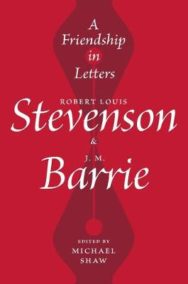‘I was struck by just how fun, playful and jesting Barrie was. And while I knew they developed a friendship, I didn’t realise just how much the friendship with Stevenson meant to Barrie.’
In A Friendship in Letters, Michael Shaw brings together correspondence between two of Scotland’s most famous writers – Robert Louis Stevenson and J. M. Barrie – for the first time. BooksfromScotland chatted to him about his book and what the letters revealed about each of them.
A Friendship in Letters: Robert Louis Stevenson & J. M. Barrie
Edited by Michael Shaw
Published by Sandstone Press
Congratulations on the publication of your book, A Friendship in Letters. When did you first discover the friendship between Robert Louis Stevenson and J. M. Barrie?
I wouldn’t say I ‘discovered’ it. It’s been known that the two corresponded since the 1890s and Stevenson’s letters (which have all been published before) made it clear that they had a sustained correspondence. But I only realised that they developed a friendship when I was doing my PhD thesis, when I was reading through Stevenson’s letters.
Barrie’s side of the correspondence with Stevenson was thought to be lost. How did you come to find his letters?
Some of Barrie’s key biographers have speculated that the letters were lost, but other scholars have known about them. When I first saw them, I didn’t realise some people had characterised them as ‘lost’. I was on a research trip at the Beinecke Library, Yale University, doing some research for my first book, The Fin-de-Siècle Scottish Revival (2020). I was investigating some manuscripts by Stevenson, Barrie and Andrew Lang, but I got through the material I had ordered quite quickly, so I had some time on my hands. I looked through the library’s catalogues and ordered material (mainly correspondence) that sounded interesting. This was when I first saw the Barrie letters to Stevenson. I simply assumed they had been published before, but I thought I would read through them while I was there. I was struck by how affectionate and fun they were (and the various things they included – such as a short playlet, in which Barrie imagines his visit to Samoa), so I resolved that I had to get a printed copy of the letters for my bookshelf. It was only when I got hold of a copy of Viola Meynell’s Letters of J. M. Barrie, which describes the letters to Stevenson as ‘lost or destroyed’, and did some more work that I realised that Barrie’s run of letters to Stevenson hadn’t been published before.
In reading Barrie’s side of the correspondence did you come to think differently of both writers?
I was struck by just how fun, playful and jesting Barrie was. And while I knew they developed a friendship, I didn’t realise just how much the friendship with Stevenson meant to Barrie. It’s an incredibly affectionate correspondence in places.
When they first started writing to each other Barrie had yet to write the work that would make him legendary. How did their correspondence inspire his work?
The correspondence inspired various Barrie works, in differing ways. Barrie wrote a poem to mark Stevenson’s death, titled ‘Scotland’s Lament’, shortly after Stevenson died, where we find some subtle references back to the correspondence. He included a chapter on Stevenson in his memoir of his mother, Margaret Ogilvy, and a character in one of Barrie’s lesser-known novels, Sentimental Tommy, is based on Stevenson. Barrie told Stevenson that he was modeling the character Captain Stroke on him, and Stevenson’s response inspired the ending of the sequel, Tommy and Grizel (I won’t give the ending away here…). Stevenson and their friendship inspired some later writings too: there are references to Treasure Island characters in the Peter Pan texts, and, in the 1920s, Barrie wrote a lovely short story imagining how he might have met Stevenson in Edinburgh. Several of these pieces are included in the book as appendices.
Though Stevenson was the more established writer, he was the one who initiated their correspondence. What do you think Stevenson appreciated from their friendship?
Stevenson had been reading some work by Barrie, which he was taken by, which prompted him to reach out. As Stevenson’s second letter shows, he was particularly fond of Barrie’s early novel, The Little Minister. I think Stevenson wanted to congratulate Barrie, but he also wanted to support him. He sometimes acts like a literary mentor at the beginning of the correspondence, giving him advice on writing to Barrie, but their relationship becomes much more equal as the correspondence progresses.
Stevenson was living his final years in Samoa when they started their correspondence. Do you think establishing a connection back to Scotland, and particularly Edinburgh, was important to him in writing to Barrie?
It absolutely was. I think Stevenson appreciated the fact that he could freely make cultural references to Scottish places and history with Barrie. He suspected that Barrie was, like him, a ‘Scotty Scot’. They don’t talk a great deal about Edinburgh, but it clearly played a role in stimulating the correspondence. Stevenson mentions their shared experiences of the ‘grey metropolis’ in the very first letter and quips: ‘no place so brands a man’.
As well as talking about literary matters, their letters cover family, love, politics, gossip; a whole range of subjects. Do you feel these letters give an insight into both writers that hasn’t been appreciated before?
I think the letters help us understand Barrie’s networks better, what he thought of other writers and writings, and his writing processes. I think we get a stronger idea of Barrie’s sense of himself too, and how deep his affection for Stevenson was.
Were you surprised to find the humour in their letters?
It would be surprising if the humour wasn’t there. I knew how funny Stevenson’s other correspondences could be, and Barrie is a great ironist and parodist in his novels and plays. They were well matched and a humourous correspondence was likely to emerge. Stevenson describes the pair of them as ‘fools’, and they enjoy poking fun at each other (and many other subjects).
Finally, what works from Stevenson and Barrie would you recommend as your favourites?
With Barrie, I’d recommend The Little Minister, Margaret Ogilvy, The Admirable Crichton and What Every Woman Knows. Farewell Miss Julie Logan (a late novella) is extraordinary. There’s so much more to Barrie than Peter Pan. With Stevenson, where to begin? There are very few I wouldn’t recommend. Treasure Island and Kidnapped are well worth returning to, and Weir of Hermiston and The Master of Ballantrae are wonderful. The Beach of Falesá, set in the Pacific Islands, is among my favourites.
A Friendship in Letters: Robert Louis Stevenson & J. M. Barrie edited by Michael Shaw is published by Sandstone Press, priced £11.99.
ALSO IN THIS ISSUE

 The Nesting
The Nesting
‘The room was suddenly charged with emotion, and I felt my lies pressing down on me like lead weight …

 Christmas Stocking Fillers!
Christmas Stocking Fillers!
‘The kindness of strangers can reduce you to your knees in a sobbing mess faster than a well-aimed p …













